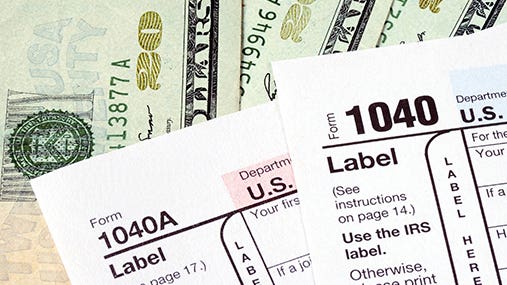Tax law updates for your 2014 tax return

The Bankrate promise
At Bankrate we strive to help you make smarter financial decisions. While we adhere to strict , this post may contain references to products from our partners. Here's an explanation for .
Each year, taxpayers gather W-2 forms and a box load of receipts in an attempt to tackle an ever-changing tax code that only grows more complex with time.
However, taxpayers may catch a break this year.
Unlike in recent years, no major changes have been made that will apply to this year’s taxes, according to Russell Stanaland, an adjunct professor at the Golden Gate University School of Law in San Francisco.
Still, a few lesser changes are in place for this season, says Stanaland, who practices in the area of taxation, estate planning and probate, and trust litigation.
In the following interview, Stanaland highlights some of the changes in store for this year’s tax season. He also discusses ways to make the tax preparation process as painless as possible.
Tax season is upon us once again. What are some of the biggest new deductions or other changes that may impact the average taxpayer this spring?
Unlike in recent years, there were no major changes to the tax law this year.
Qualified dividends are still taxed at preferential capital gains rates. The annual exclusion for gifts is still $14,000. The exclusion amount for estate and gift tax was raised to $5.43 million per person. The top estate tax rate is 40 percent.
The following summarizes some of the changes that did occur:
- One hundred percent exclusion gain on qualified small-business stock. Congress extended the total exclusion of gain on the sale of qualified small-business stock acquired in 2010 through 2014. The taxpayer must have acquired the stock at original issue and must hold the stock for five years. The corporation must have less than $50 million in assets at all times. If the above conditions are met, all gain is exempt from tax on sale.
- ABLE programs. A completely new provision was added to the tax code to benefit blind or disabled youth and young adults. Section 529A allows states to establish ABLE programs to benefit someone who became blind or disabled before achieving the age of 26. The beneficiary’s family or friends can make contributions to the program.
- Virtual currency (bitcoin). The IRS announced that it considers virtual currency (VC) (to be) property, as opposed to a foreign currency. This means that every time someone uses VC to make a purchase, it is a taxable event. There is gain or loss equal to the value of what is purchased, less the amount paid for the VC. This will make for complicated taxes for anyone who uses VC.
- Bond discount and premium. Brokerage houses will now include information about bond discount and premium on the 1099 forms issued for 2014. This information, which was somewhat difficult for most taxpayers to obtain in the past, can be used to minimize taxes. The information will be very helpful for tax preparers.
This year will be the first that the Obamacare tax credit shows up on tax returns nationwide. Is this credit likely to complicate returns for people?
The Affordable Care Act, or Obamacare, will undoubtedly complicate some tax returns. Everyone must report their coverage status and the coverage status of all of their dependents on their form 1040. If everyone had coverage for the entire year, there are no complications.
However, if anyone was not covered and the family does not meet one of the exemptions, a penalty will apply. The penalty is the greater of $95 or 1 percent of adjusted gross income, less the standard deduction and exemption amounts. For example, a couple making $150,000 who lack coverage for the entire year will incur a penalty of $1,297.
If a taxpayer obtained health care coverage through a state exchange and got a subsidy, it will have to be reported on the Form 1040. It is likely that many people who got the subsidies will be in for an unpleasant surprise when they prepare their returns.
When they first obtained coverage, they were asked to estimate their income for 2014. The lower their income, the greater the amount of subsidy they were awarded. This is an incentive to understate income.
When actual income is reported on the Form 1040, the true amount of the subsidy must be calculated. The difference between the actual subsidy and the amount allowed during the year must be repaid. The difference can be several thousand dollars.
Some experts have said a combination of an increasingly complex tax code and a budget-constrained IRS will make this an especially challenging tax year. In general, what can people do to make the filing process go more smoothly?
The best way to ensure your tax return is processed quickly and your refund issued promptly is to provide your tax preparer with accurate information. Make sure you have all of your 1099 forms.
In the past few years, it has been common for brokerage houses to issue corrected 1099 forms. That trend is likely to continue with new reporting requirements. It may be best to wait two weeks after you receive your first 1099 form before you submit it to your tax preparer.
The best way to ensure a prompt refund is to file your returns electronically and to have the refund deposited directly to your bank account. In past years, many taxpayers who did this received their refund within three weeks of filing.
What are some of the biggest and most common mistakes that you see taxpayers make year after year?
The most common mistakes I see usually involve business expenses and lack of documentation. A business owner is allowed to deduct all ordinary and necessary expenses of running the business. On audit, you must produce reasonable documentation of those expenses.
This includes copies of vendor invoices, canceled checks, and credit card statements that substantiate the deductions.
A business owner is allowed to deduct expenses related to business use of his or her automobile. In order to do so, a log of business miles must be maintained. This log must include the date, the miles driven and the business purpose.
This must be a “contemporaneous” record. The definition of contemporaneous does not include preparation after it is requested on audit. Most people just don’t do this. The IRS may disallow all auto expense if this log is not produced.
Another common mistake is underreporting of income. One of the first things an auditor does when beginning an audit is to request all of the taxpayer’s bank statements. The auditor then adds up all of the deposits and compares it to the gross income reported on the tax return. If the total of the deposits is greater than the income reported, the taxpayer must explain the difference.
Other mistakes include not making estimated payments on time, not establishing retirement accounts when they are available, forgetting about charitable deductions and claiming a deduction for a home office when it is not appropriate.
Each spring, people tear their hair out in tax-related frustration. They pledge to be more prepared next year, but never quite make good. What tips can you offer people to help them prepare throughout the year for next year’s return?
The best way to be prepared for taxes is to be organized. This can actually be very simple.
Most problems with tax preparation are the result of missing documents. I tell my clients to get a large envelope and label it “Tax Documents.” Every time you get something in the mail that may be tax-related, put it in the envelope. Every time you make a charitable donation, put a note in the envelope.
At the end of the year when your 1099 forms and annual brokerage statements arrive, put them in the envelope and everything will be ready for your tax preparer.
Related Articles

Tax season 2023: Everything to know before you file and how to get your refund fast


